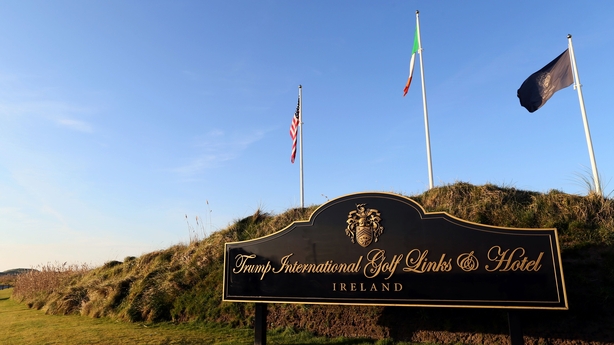A hotel belonging to Donald Trump said they were trying to protect fragile sand dunes from getting trampled in the latest twist in a saga over the erection of fencing near his luxury Irish resort.
In a letter to Clare County Council, Trump International Golf Links and Hotel in Doonbeg denied they had carried out any unauthorised development on a nearby beach and dunes.
They said they had installed fencing to combat what they called "the regular trampling and traversing" of the dunes at Doughmore Strand.
The hotel said it had been causing "significant erosion" and was undermining the "fragile dune system" in the area.
In their letter, they said Clare County Council had themselves erected signage to try and keep people from walking up and down the dunes.
"However, the issue has persisted and this had led to further undermining of the dunes," the Trump hotel added.
"In order to prevent further activity on and damage to the dunes, fencing was erected along the sea front. The fencing erected is similar to fencing which is already in place along the top of the dunes which is designed to stop people (golfers) from walking down the dune face," it stated.
Trump's hotel said works to manage coastal erosion had previously been allowed by the council and that "sand trap fencing" had long been part of those efforts.
Managing director Joe Russell wrote: "We deny the existence of any unauthorised development on the lands, however, we are committed to engaging with the planning authority as part of this process and in respect of any future conservation management activities."
Following receipt of the letter in mid-October, Clare County Council dispatched planning officials to inspect the fencing on dunes around the Trump resort.
In a report, the official said the fencing had been "extended significantly" since two previous visits that he had made following which the original warning letter had issued.
"During my site visit, a golf course maintenance buggy/vehicle approached the northern end of [a] fenced area and it appeared that the person driving same was preparing for a further fence extension," the official said.
He also noted that a line of plastic silage or hay round bales had been placed to the east of the fencing at one location.
The planning official said the fencing was a "physical obstruction" to the natural circulation of sediment and organic matter either in or adjacent to a special area of conservation.

He reiterated the conclusion from a previous inspection that the works were not exempted development, had no planning permission, and were considered to be unauthorised.
The official said another letter should be sent to TIGL Enterprises Limited - the company that runs the hotel - advising them of this and asking what steps they would take to resolve the planning issue.
Separately, records from the National Parks and Wildlife Service (NPWS) reveal experts there thought there was little chance a fence, even if it was allowed, would prove successful.
In internal discussions, regional manager Dr Enda Mooney said attempts had been made over the years to protect the dunes, all of which had failed.
"Ultimately, this is probably an unsolvable problem with increasing sea levels and bigger storms. This however was apparent prior to the construction of the golf course!," he said.
Wildlife inspector Dr Aoife Delaney responded to say she didn't like to be "all doom and gloom" but agreed that dune protection measures at Doonbeg were unlikely to be successful.
In another email, she said: "These fences are better than a hard wall or boulders, but a permanent fence in a mobile system always raises worries".
"I think that we need to have consistent messaging across the coast at this time, and we are attempting to guide communities towards sensitive approaches with a proven track record," she added.
Reporting by Ken Foxe

